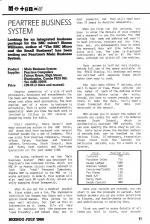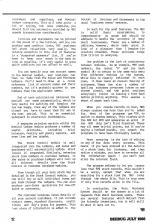
Beebug
 1st July 1986
1st July 1986
Categories: Review: Software
Author: Simon Williams
Publisher: Peartree
Machine: BBC Model B
Published in Beebug Volume 5 Number 3
Looking for an integrated business package for the BBC Micro? Simon Williams, author of The BBC And The Small Business, has been testing out Peartree's Main Business System
Peartree Business System (Peartree)
Despite something of a glut of word processors, databases and spreadsheets for the Beeb and Master, recent surveys have shown that after word processing, the most popular use of a micro in business is accounting. This is quite understandable, especially when you know how much work is involved in filling in VAT returns or preparing books for audit.
Until recently, there haven't been many accounting suites on the BBC Micro, and those that have surfaced cost several hundred pounds for a set of ledgers. This new suite from Peartree Computers, though, offers Sales, Purchase and Nominal ledgers, Invoicing, Stock Control, Bank and Petty Cash Control and Pro-Forma Quotations all for just under £100.
The suite, referred to as the 'Main Business System' (MBS) was developed for Peartree's own business micros, which are BBC B+ or Master circuit boards re-boxed to look like 'real' Personal Computers. Shadow RAM is essential to run MBS as it works entirely in mode @. Your system will also need twin 8 track discs, unless you enjoy swapping discs frequently.
What do you get for a hundred pounds? At first sight, not a lot. The impressive inch-thick box houses two discs and a thin spiral-bound manual. This proves to be very well written, but just as thin on information as it looks. It's all very well to maintain that the programs are 'user friendly', and indeed they are in most respects; but they still need more than 35 pages to describe adequately.
When you first run the program, you have to enter the details of your company and a password to use the system. The MBS records the name and address and uses it to head invoices, receipts and the like. Once set, you subsequently have to enter the password, date and time before the suite will run. The time is displayed continuously while you're at the main menu, although not within all the modules.
Each screen is laid out very clearly, making full use of the space available on the 80x32 display. All headings and menus are outlined with separate boxes which makes them easy to read.
The main menu offers 11 options, plus exit to Basic or View. These options are the names of each of the modules within the system. Before using the suite, though, you have to create records on your discs to take the data. You'll need a blank formatted disc for data (not mentioned in the manual).
MBS allows you to select the number of records you create for each of its modules except Stock Control, which is automatically assigned 900 records. You can also specify the drive they're put on. The table below shows the maximum numbers of records that can be handled by the various files. If necessary, transaction files could hold the records for particular periods, e.g. for a month or a quarter.
Once your records are created, you can start to use the programs in earnest. Each module prompts you as you enter selections or figures, and double-checks on deletions and modifications to existing data.
First you need to enter details of all items you hold in stock, your account customers and suppliers, and Nominal Ledger categories. This will take quite a bit of typing, but once complete, you should find the automation provided by MBS speeds transactions considerably.
Invoices and statements can be printed at the press of a few buttons, and you can produce aged creditor lists, VAT analyses and stock valuations very easily. One notable exception to this list of features is a 'suggested payments' list. If you're keen to keep your money in the bank as long as possible, it's very useful to know which creditors you can afford to stall.
You can specify your own account names in the Nominal Ledger, and postings can then be made from the Sales and Purchase Ledgers. You'll need to draw up a cross reference list of account names and their numbers, but it's probably quicker to use numbers than the equivalent names.
End of term calculations (whatever the period) are made automatically, which is very useful for auditing and keeping the tax man happy. Once any of the ledgers are closed you have to reset them for use in the next period. This is an essential safeguard in electronic bookkeeping.
A separate printing section within the Nominal Ledger module produces a number of useful printouts, including trial balances, monthly and yearly reports, and even line and bar graphs.
The Stock Control module is well integrated into the ledgers, and sales and purchases will automatically update stock levels if requested. Similarly, entering stock item numbers or customer numbers in the sales or purchase ledgers will call up all relevant details from the Stock Control or Customer Database modules.
Even though all your main stock may be detailed in the Stock Control module, you can still buy or sell individual items and put them through the ledgers. You can also produce pro-forma quotations for one-off sales or contracts.
The Customer Database takes details of all your account customers. It can include contact names, standard discounts, credit limits and day's grace for payment. This last piece of information is added to the bottom of invoices -and statements in the usual 'business terms' message.
So much for the good features. The MBS is solid Basic programming, is comprehensive in scope and should be adequate to handle the accounts of many small businesses. There are a number of oddities, however, which make using it less of a pleasure than I imagine its creators intended. These problems range from trivial to annoying.
One problem is the lack of consistency between modules. As an example, MBS uses numbers, the letter 'R' and the hash symbol (#) to return to the same main menu from different modules in the system. While this is clearly indicated in each case, it does leave an overall feeling of bittyness. There are also a number of spelling mistakes on-screen (three on one screen alone), and the print routines annoyingly insist on issuing a form feed before printing anything. This wastes a sheet of paper each time.
When you create records on disc, MBS always creates one more than you've asked for. Most of the programs use *SH. to switch on shadow memory. This clashes with the AMX Art ROM and generates an error if the AMX chip isn't first disabled. These may all seem trivial points, but if you're paying a hundred pounds, you expect the programs to have been thoroughly tested.
More annoying is the lack of editing on any of the data entry screens. This means if you have entered all the details of a stock item, for instance, and then notice a mistake, you have to re-enter all the information again - you can't just alter the relevant field.
The program refuses to let you create less than 900 stock records. This wouldn't be a worry, except that when you are searching for a stock item the MBS looks through the whole file. This is true even if only five records exist in the file.
In conclusion, the Main Business System should be the answer to a lot of requests from small business users. There are several features which detract from its friendly intentions, but it will still do what it sets out to.
| File | Maximum Size |
| Customer | 7504 |
| Purchase Order | 750 |
| Sales Ledger | 1300 |
| Nominal Ledger | 600 |
| Invoicing/Credit | 130 |
| Pro Forma | 130 |
| Bank A/C | 225 |
| Petty Cash | 225 |
| Stock Control | 900 |
Other BBC Model B Game Reviews By Simon Williams
This article was converted to a web page from the following pages of Beebug Volume 5 Number 3.












